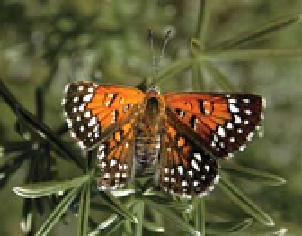Biology Reference
In-Depth Information
wetlands due to agriculture, water diversion, and other development projects is the
primary cause of their population decline.
YEAR LISTED (STATE THREATENED)
: 1993
SIZE
: 46
inches tall
POPULATION AT LISTING
: unknown
POPULATION TODAY
: 6,000-6,800
Green Sturgeon
(
Acipenser mediros-
tris
) This largest of California's freshwa-
ter fish looks every inch the Jurassic era
throwback it is. Bony plates of armor on
its back and a vacuum-hose mouth only
add to the alien specter of its man-
sized frame. Yet 200 million years of
evolution were not enough to prepare
the Green Sturgeon for its encounter
with industrial-age humans. The one-two
punch of overfishing and dams installed on its spawning streams reduced the
southern distinct population segment, which spawns solely in the Sacramento
River system, by 96 percent between 2000 and 2006.
YEAR LISTED
: 2006
SIZE
: 6.5-
7.2 feet
STATUS
: threatened
POPULATION SIZE
: unknown
POPULATION TODAY
: unknown
Green Sturgeon. (Matt Manuel)
Lange's Metalmark Butterfly
(
Apo-
demia mormo langei
) With fiery orange
forewings and black dorsal wings speck-
led with white, Lange's Metalmark But-
terfly cuts a dashing figure as it flits
above the sands of the Antioch Dunes
National Wildlife Refuge. Adults feed on
nectar from several types of dune wild-
flowers, but they lay their eggs exclu-
sively on leaves of naked stemmed
buckwheat—the only food their larvae
will eat. A century of sand mining and
industrial development at the confluence of the Sacramento and San Joaquin riv-
ers has diminished the butterfly's habitat, while nonnative vegetation has stabi-
lized the shifting sands its host buckwheat needs to propagate. Today, Lange's
Metalmark Butterfly is found almost exclusively within the dunes' refuge borders.
YEAR LISTED (FEDERALLY ENDANGERED)
: 1976
SIZE
: wingspan of 1-1.5 inches
POPULATION IN
1986
: <200
POPULATION TODAY
: several thousand
Lange's Metalmark Butterfly. (U.S. Fish
and Wildlife Service)
Salt Marsh Harvest Mouse
(
Reithrodontomys raviventris
) About the length of a
human thumb and weighing less than a nickel, the Salt Marsh Harvest Mouse
eats the salty leaves and seeds of tidal marsh plants, then washes it all down with
sips of brackish seawater. Secretive and almost never seen, it prefers the dense
cover of pickleweed stands and generally emerges only at night. Its numbers have



